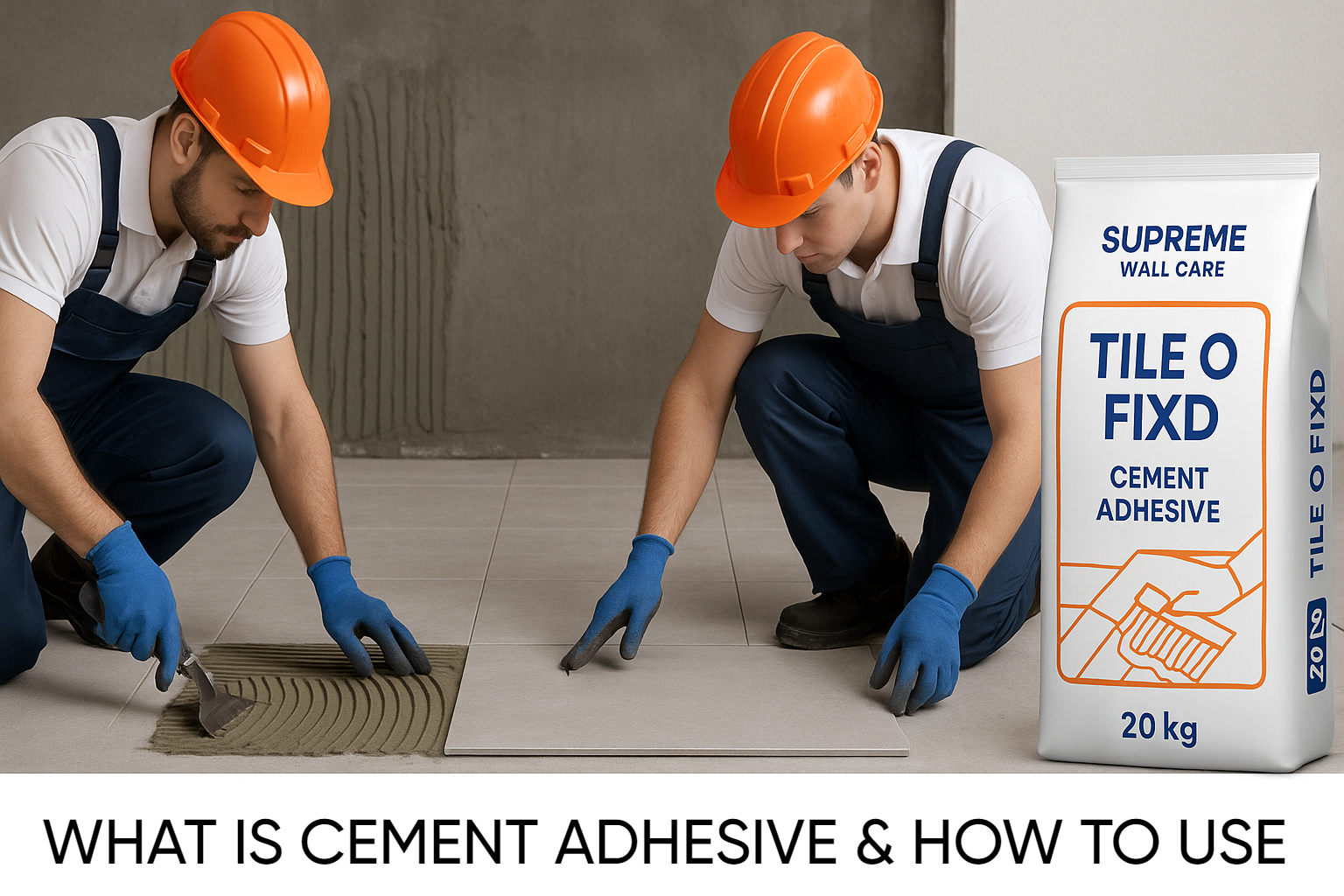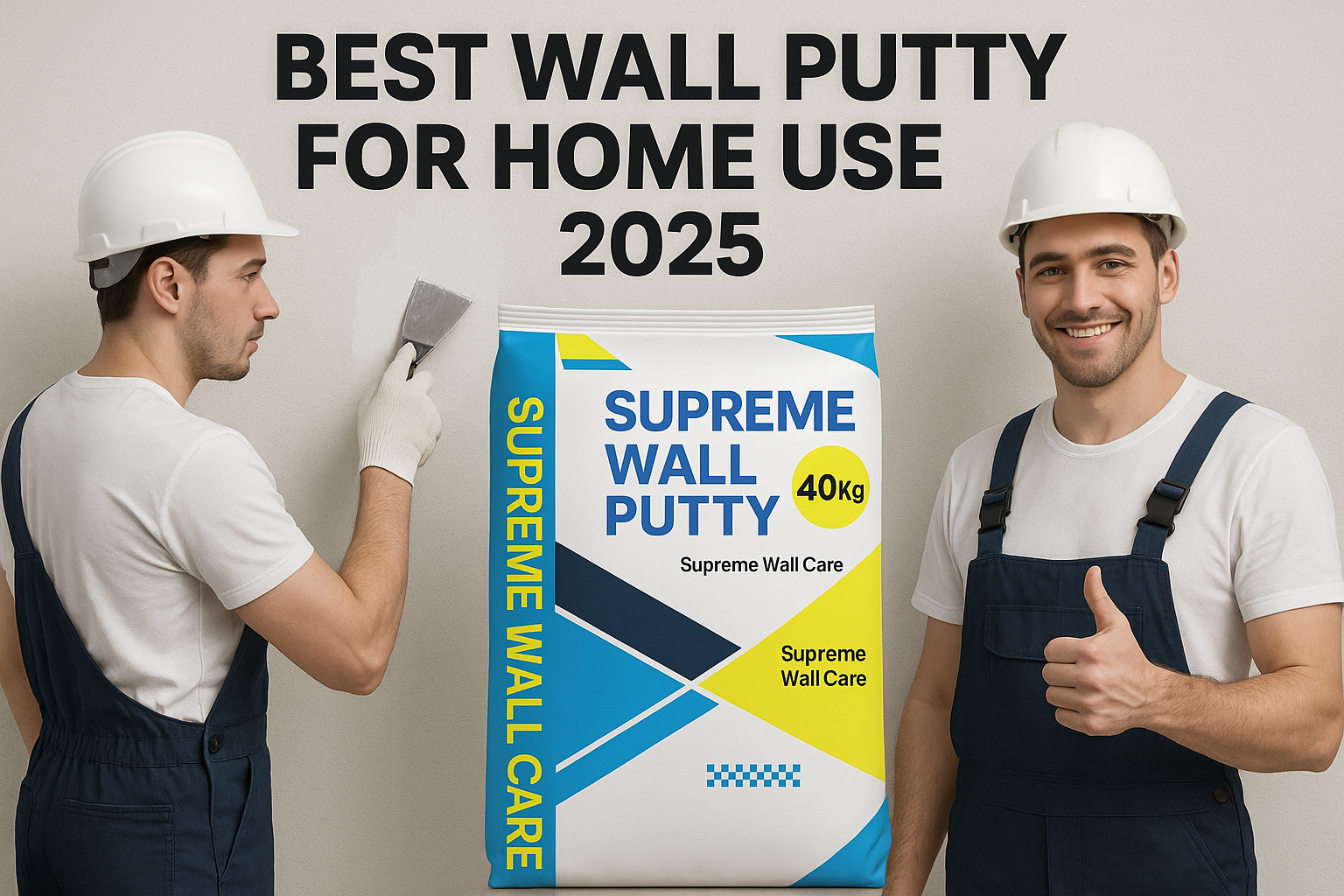Table of Contents
ToggleWhat Is Cement Adhesive and Why Is It Replacing Traditional Mortar?
Tiles, marble, granite, and natural stones are stunning materials that define the aesthetics and strength of modern architecture. From luxurious interiors to durable exteriors, these materials bring both style and substance to residential and commercial spaces. However, their long-term performance and visual appeal depend greatly on one crucial factor: the method and materials used for fixing them in place. This is where cement adhesive, commonly referred to as tile adhesive, becomes essential.
Unlike traditional sand – cement mortar, modern cement adhesives are specially formulated to provide superior bonding strength, extended working time, and enhanced moisture resistance. These properties make them an ideal solution for today’s tile and stone installation needs, especially in areas exposed to water, heat, or movement. Whether you’re laying ceramic tiles in a bathroom, installing marble flooring in a living room, or fixing granite cladding on a building facade, a high-quality cement adhesive ensures a reliable, long-lasting, and flawless finish. It not only enhances the life of your tiles but also simplifies the installation process, making it quicker and cleaner.
In this comprehensive guide, we cover everything you need to know about cement tile adhesive – from what it is and how to use it, to answering the most searched questions like:
- What is cement adhesive used for?
- Best cement adhesive for tiles
- Can tile adhesive replace cement mortar?
- Which adhesive is best for marble and granite?
Let’s begin !
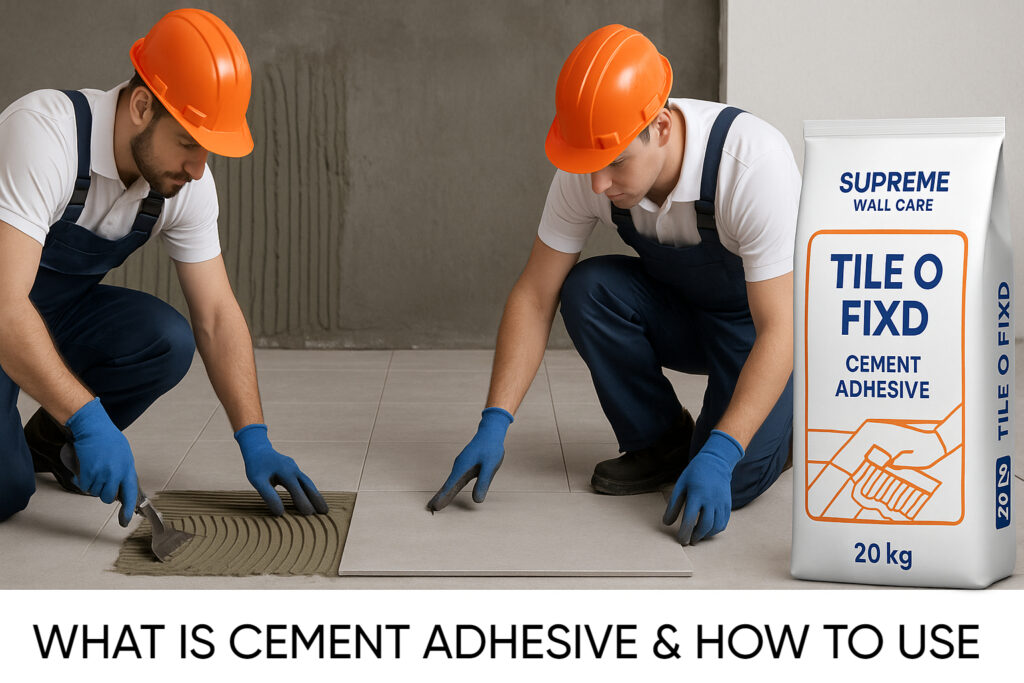
What is Cement Adhesive Used For?
Cement adhesive is a ready-mix tile fixing compound used to adhere materials like:
- Ceramic, porcelain, vitrified, and mosaic tiles
- Natural stones like marble and granite
- Artificial cladding and heavy stones
- Large-format tiles and slabs
It’s commonly used in:
- Residential flooring and bathrooms
- Commercial spaces like malls and hospitals
- Exterior cladding, swimming pools, and balconies
Cement adhesives are also formulated to withstand thermal changes, moisture, and structural movement, which makes them far superior to cement-sand mortar.
Types of Cement Adhesive and Their Uses :
There are multiple classes of cement adhesives tailored to suit various substrates, tile types, and environmental conditions. These classifications are standardized under IS 15477 (Indian Standard) and ISO 13007 (International Standard), helping professionals choose the right product for each application:
- C1 – Standard Cement Adhesive
Ideal for fixing ceramic tiles on cementitious substrates like plastered walls and cement floors.
Best suited for dry, indoor areas such as living rooms or bedrooms.
- C2 – Improved Performance Adhesive
Offers higher bond strength and better flexibility than C1.
Suitable for vitrified tiles, porcelain tiles, and natural stones.
Can handle light thermal and structural movement, making it more versatile.
- C2TE – Enhanced with Slip Resistance & Extended Open Time
Specially formulated for vertical applications, large-format tiles, and cladding work.
Features anti-sag properties to prevent tiles from slipping during installation.
Works well for outdoor installations, wet zones, and high-humidity areas like bathrooms, balconies, and facades.
Special Adhesives :
- Fast-setting: For urgent jobs like commercial spaces or quick renovations.
- Waterproof: Essential for swimming pools, bathrooms, terraces, and kitchens.
- Flexible Adhesives: Designed for areas with vibration, movement, or temperature variations, such as wooden floors, elevators, or external facades.
Choosing the right class of adhesive ensures your tiles not only look perfect but also last longer without delamination, cracking, or water damage.
Cement Adhesive vs Tile Mortar: Which One Is Better?
While traditional tile mortar – typically a mix of cement and sand- is still used in some regions due to its low cost and familiarity, it falls short when compared to modern cement adhesives in terms of performance, durability, and ease of installation. Traditional mortar has a lower bond strength, which can lead to tile debonding over time, especially in high-traffic or moisture-prone areas. In contrast, cement adhesives are formulated with polymers and special additives that provide superior bonding capabilities, even on smooth and low-absorption surfaces like vitrified tiles or natural stone.
One of the major drawbacks of traditional mortar is its poor water resistance. It tends to absorb moisture, which can lead to swelling, cracks, and eventually tile failure. Cement adhesives, on the other hand, are highly water-resistant, making them ideal for bathrooms, kitchens, balconies, and even submerged areas like swimming pools. Additionally, traditional mortar has high shrinkage, which can result in gaps beneath tiles, uneven surfaces, or cracked grout lines. Cement adhesives minimize this issue by offering low shrinkage and consistent application thickness, ensuring a smoother, more professional finish.
Installation efficiency is another key factor. Applying cement adhesive is generally faster and cleaner than traditional mortar, which requires more curing time and surface preparation. The quick-setting nature of modern adhesives allows for faster project completion, especially beneficial in commercial or time-sensitive builds. Moreover, cement adhesives offer a degree of flexibility, which helps them absorb slight structural movements or vibrations—something traditional mortar cannot handle due to its rigid composition.
In summary, while traditional mortar may still find use in low-budget or small-scale projects, cement adhesive clearly outperforms it across all critical parameters, including bond strength, water resistance, shrinkage, speed of installation, and flexibility. For contractors, architects, and homeowners who prioritize quality and long-term performance, cement adhesive is the modern, reliable choice for tile and stone installations.
How to Use Cement Adhesive for Tiles: Step-by-Step Guide
Installing tiles using adhesive requires precision and method. Here’s how:
Step 1: Surface Preparation
- Clean the substrate thoroughly
- Remove dust, oil, paint, and loose particles
Step 2: Mixing the Adhesive
- Mix 20 kg adhesive with approx. 5–6 liters of clean water
- Use a low-speed drill to get lump-free consistency
- Let it sit for 5 mins, then stir again
Step 3: Applying the Adhesive
- Spread with a notched trowel
- Maintain uniform thickness (3–6 mm for walls, 6–12 mm for floors)
Step 4: Fixing Tiles
- Press tiles firmly
- Use spacers to maintain even gaps
- Adjust within open time (~30 mins)
- Wait at least 24 hours before walking or grouting
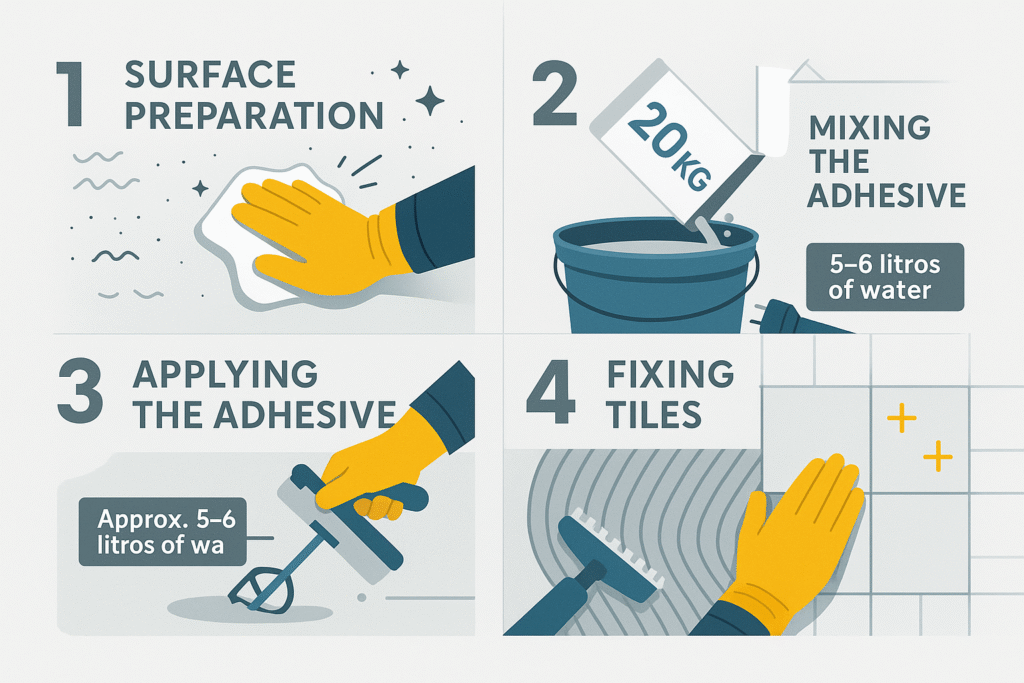
Can Tile Adhesive Be Used on Walls? And Other Common Queries
Yes, absolutely. Modern C2TE adhesives are formulated with anti-slip properties, making them perfect for vertical applications such as wall – tiles and stone cladding. If you’re working on wall finishes, especially in interiors, understanding the difference between tile adhesive and
wall putty is essential for achieving both aesthetic and functional excellence.
More Google Questions Answered:
- What is the best tile adhesive for bathrooms?
Waterproof adhesive with high bond strength like Tile O Fix. - Can tile adhesive be used instead of cement?
Yes, especially for high-end applications requiring precision and strength. - How thick should tile adhesive be applied?
3–6 mm for walls, up to 12 mm for floors.
Best Cement Adhesive for Tiles, Marble & Granite
Heavy stones like marble and granite are not only expensive but also delicate and dense. Installing them requires a specialized adhesive that can support their weight, prevent sagging, and resist weather damage. Using the right adhesive ensures long-term durability, safety, and a flawless finish in both indoor and outdoor settings.
Ideal Adhesive Features:
- Polymer-modified
- Anti-sag (for vertical surfaces)
- Waterproof
Recommended Product : Tile O Fix by Supreme Wall Care
Waterproof Cement Adhesive for Outdoor and Wet Areas
Outdoor areas and wet zones require high-performance adhesives that can resist water absorption, capillary rise, thermal expansion, and mold or fungal growth. To ensure lasting results in challenging environments like pools, balconies, terraces, and kitchens, choose products labeled as waterproof and flexible. Opt for adhesives with C2TE or C2TES2 classification, which are specifically formulated to handle moisture exposure and temperature variations without compromising tile bonding or durability.
In these areas, constant exposure to rain, cleaning agents, and humidity can weaken traditional adhesives over time. That’s why specially engineered tile adhesives are essential—they maintain structural integrity even under harsh environmental conditions. Additionally, these adhesives prevent tile detachment, surface discoloration, and efflorescence, which are common in poorly bonded outdoor installations. Investing in a quality waterproof adhesive not only protects the substrate but also extends the life and appearance of the tilework, saving future maintenance costs.
How Long Does Tile Adhesive Take to Dry?
The drying time of tile adhesive depends on several factors including tile type, temperature, and humidity.
Normal tiles: 24 hours
Large slabs: 48–72 hours
Grouting: After 24 hours
Heavy loads: 3–5 days
For best results, always follow the manufacturer’s instructions. This ensures strong bonding, prevents shifting, and maximizes the durability of your tile installation.
Tile on Tile Application: Can Tile Adhesive Do It?
Yes, cement adhesive allows for tile-on-tile application, making it a smart choice for renovations and upgrades. This method eliminates the need to break or remove existing tiles, saving time, labor, and material disposal costs. It’s especially useful in commercial spaces or homes where downtime must be minimized. However, for successful results, proper surface preparation is crucial. The underlying tiles must be stable and clean to ensure proper bonding.
Ensure:
- Old tiles are properly cleaned
- No hollow sounds or loose tiles
- Use a high-performance adhesive like Tile O Fix
Common Mistakes to Avoid When Using Cement Adhesive
Even the best tile adhesive can fail if not applied correctly. Simple mistakes during application can compromise the entire installation, leading to costly repairs and poor aesthetics. To achieve a durable, professional finish that lasts for years, it’s important to avoid these common errors during the tiling process
Avoid these to ensure long-lasting results:
❌ Mixing adhesive inconsistently
❌ Applying on dirty or damp substrates
❌ Delayed tile fixing beyond open time
❌ Inadequate trowel size
❌ Skipping expansion joints
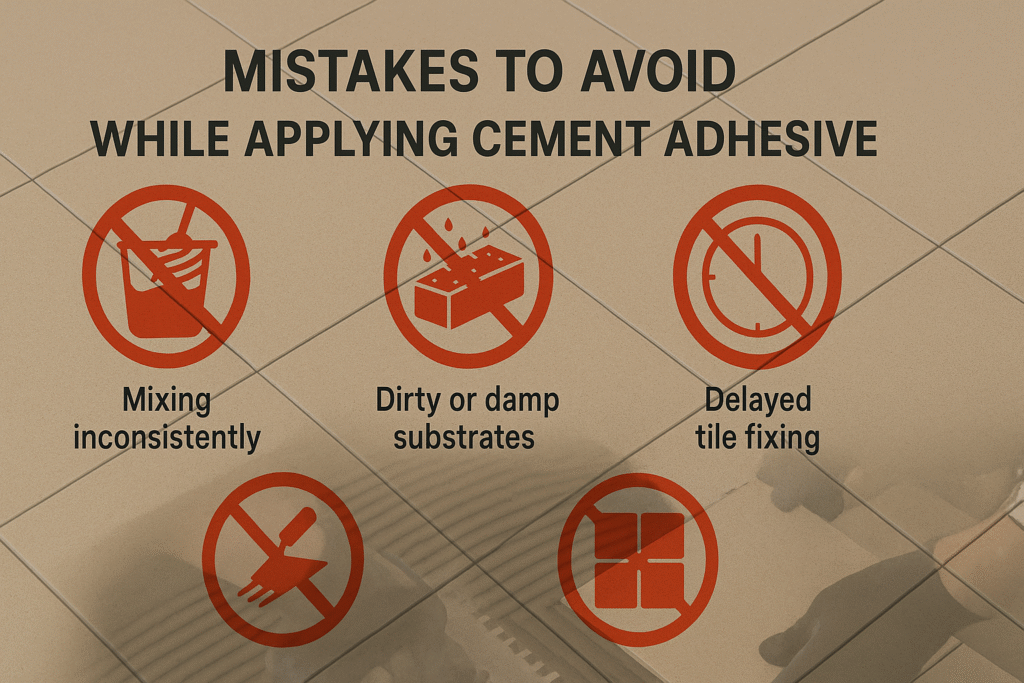
Frequently Asked Questions (FAQs) About Cement Adhesive –
Q: Can I use cement adhesive over plywood or gypsum?
Yes, with proper priming and flexible adhesive.
Q: What is the coverage of 20 kg cement adhesive?
Approximately 4–6 sq. meters, depending on tile size.
Q: Does tile adhesive need curing?
No water curing needed—just let it dry naturally.
Q: Is tile adhesive waterproof?
Only if specified on the pack (like Tile O Fix).
How to Choose the Right Cement Adhesive for Your Project?
Selecting the correct cement adhesive is crucial for a successful tile installation. The right choice depends on several factors, including the type of tile or stone, the surface it’s being applied to, and the environmental conditions. For example, C1 adhesives are sufficient for basic indoor ceramic tiling on plastered walls. However, for vitrified tiles, porcelain, or natural stones like marble and granite, a C2 or C2TE adhesive is more appropriate due to higher bond strength and flexibility. For wet areas or exteriors, always go for waterproof and anti-sag formulas, especially those labeled C2TES2. If the substrate is prone to vibration or movement, opt for a flexible polymer-modified adhesive. Carefully read the manufacturer’s label, check compatibility, and when in doubt, consult a technical expert. Choosing the right adhesive ensures durability, safety, and performance for years to come.
Key Points to Consider When Choosing Tile Adhesive:
- Type of tile (ceramic, porcelain, natural stone)
- Surface condition (plastered walls, cement floors, etc.)
- Environmental conditions (wet areas, outdoor surfaces)
- Adhesive strength (C1 for basic use, C2 for high-performance)
- Special features (waterproof, anti-sag, flexible)
Conclusion: Cement Adhesive Is the Future of Tiling & Cladding
Cement adhesive has revolutionized the tiling industry, offering unparalleled bonding strength and versatility. Whether you’re working with ceramic flooring or marble wall cladding, the right adhesive guarantees durability, resistance to moisture, and precise installation. The key to a successful project lies in choosing the appropriate adhesive for your specific needs—ensuring structural integrity, long-lasting results, and an aesthetically pleasing finish. By understanding the various types of adhesives available and their applications, you can avoid common pitfalls and achieve a professional, seamless result. Remember, a high-quality adhesive is the foundation of every successful tiling job.



